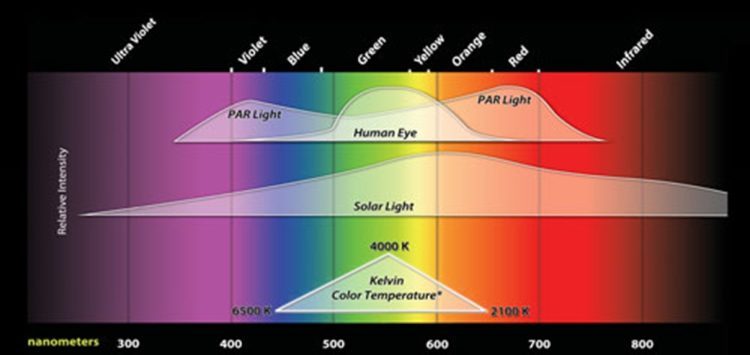Forget everything you’ve read about grow lights up til now, because it’s likely your mind has been pumped full of marketing hype and misinformation, part of which is a shortcoming in how the lighting industry as a whole measures light for humans – not plants. Look past the slick advertising, the cool logos, and claims. Here are the realities no indoor gardener should be without, because no matter how perfect everything else is – your harvest will be lacking or miserable if the plant lighting is inferior or all wrong.
This is a guest post written by Darryl Cotton at Inda-Gro Induction Lighting, a mastermind on photosynthesis and what it takes to coax the ultimate crop from what you’ve got planted in your grow room or tent.
Plant Lighting Fundamentals
Knowing that light plays such a critical role in growing plants indoors, it’s important to have the proper quality and quantity of light available to the plant – as it needs it. Insufficient light levels will reduce a plant’s overall weight, and cause symptoms of stress, decreased nodule density, as well as lead to smaller leaves. But too much light can damage plants from heat, excessive IR heat radiation, or extreme UV radiation. Ouch!
A plant will benefit to some degree from all the light wavelengths or spectra that the eye sees, but they respond best to spectral regions at the outer edges of peak human vision. If the artificial light spectrum is narrowly emitted, or missing altogether, then the plants will not develop to the fullest leafy vegetative, or bulky flowering stages that natural sunlight would have provided.
Standard visual measurements used for classifying visible light levels and color temperatures, such as Kelvin, CRI, Lux, Foot Candles, or Lumens, are not entirely applicable when selecting or measuring plant lighting. For example; we use Kelvin temperatures to describe the color of light within our visible spectrum.
Growers that are overly influenced by a lamp’s Kelvin rating and visible color, may also believe that their plants PAR needs have been entirely met. However, the chart shown here demonstrates how Kelvin temperatures and visible light have little contributive influence on the plants maximum PAR regions of UV and IR light.
Kelvin values were first developed to give artists, photographers, window dressers, etc. a way of communicating how something will look under different “temperature” lamps. Kelvin ratings have no absolute spectral values in determining if that rating will benefit a plant’s PAR requirements. To a grower, a Kelvin rating should be used as a ballpark indicator of how much red or blue light is being emitted within the visible range, and not for indicating the light’s PAR Value.
The chart below depicts the electromagnetic spectrum of light wavelengths from the low-level ultraviolet (UV) on into the infrared (IR) wavelengths. Measured in nanometers, the wavelengths consist of both visible and invisible light. Of particular importance to plants would be wavelengths within spectrums known as the PAR regions which are mostly outside of our visible light regions. While plants do benefit to a small degree from the wavelengths within our visible spectrums, plants respond best to PAR wavelengths within the UV and IR regions outside of our visible light ranges.

WAVES
All light consists of electromagnetic waves in a spectrum that ranges from the low-end ultraviolet (UV) to the high-end infrared (IR) of the spectrum. We measure the wavelength in nanometers (nm), which consists of both visible and invisible light.
PARTICLES
For this measurement of light we use PHOTONS, which are a quantum or individual unit. Since individual photons possess tiny amounts of energy, photons are then measured in units of moles (mol), which are 6.02 x 1023 photons. Micromoles (µmol) are one-millionth of a mole.
QUALITY
Photons have different amounts of energy, determined by their wavelengths. Light quality is the relative number of light particles at each wavelength. Light quality refers to the spectral distribution of light, or the relative number of photons of each portion of the spectrum, both visible and invisible that our light emits.
PAR LIGHT
During the photosynthetic process where the plant turns light into its energy it requires certain wavelengths – spectrums that we refer to as Photosynthetic Active Radiation, or PAR for short. While PAR light spectrum ranges between 380-720 nm, the region brightest to human vision (555 nm – Green, Yellow and Orange) has the least effect on plants. Consequently light meters that measure human vision levels (lumens,lux,footcandles) are not as effective as quantum type meters in determining if plant lighting levels (YPF, PPF) are actually being met.
MEASURING PAR
Quantum light meters differ from visible light meters in that they will tell you how many photons are striking a square meter per second. Taken as a moment in time ‘incident reading’ at the plant, and the unit of measurement given will be the measure in micromoles, and expressed as µmol/m2. To give you some reference, using a quantum meter, sunlight on a cloudless day would measure 2,000 µmoles at the leaves.
Light is essential to our vision and plant growth, but the way our eyes and plants react to this light are an entirely different processes. While the overall physics and science of lighting can be complex, reducing it to it’s bare elements, and primarily concentrating on the important plant/light interactions, and how we measure that light makes it a lot easier to understand.
# #
You’ll find a wealth of further information in the articles written by Darryl and his colleagues in the Resources section of his website: Inda-Gro.com. The electromagnetic spectrum chart image in this article is courtesy of Darryl Cotton.